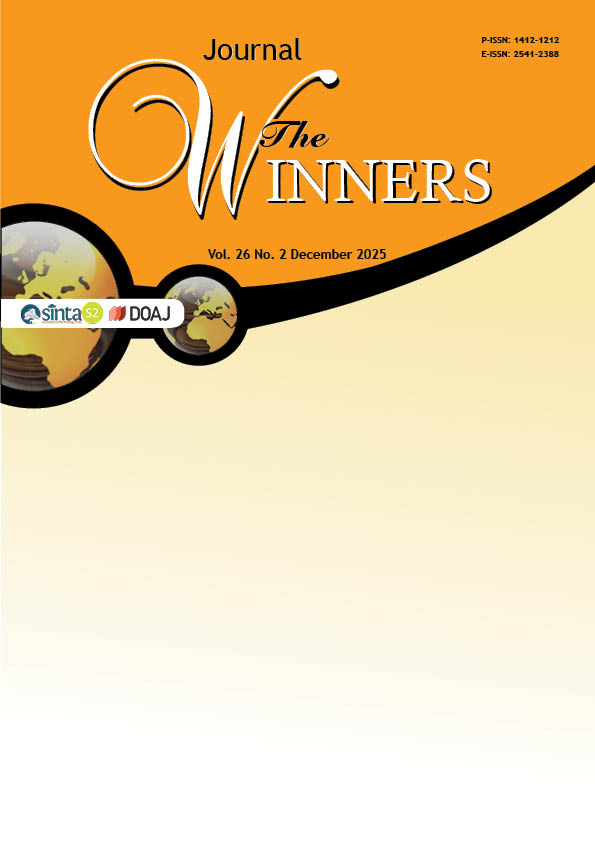The Impact of Perceived Usefulness, Convenience, and Perceived Augmentation on Purchase Intention: A Study of Virtual Try-On for Cosmetic Products
DOI:
https://doi.org/10.21512/tw.v26i2.13634Keywords:
virtual try-on, mobile commerce, customer engagement, purchase intentionAbstract
The COVID-19 pandemic has accelerated the shift toward online shopping, especially for cosmetic products. However, a major challenge remains: consumers cannot physically try on products before purchase. Augmented reality (AR) and virtual try-on features address this issue by allowing consumers to virtually try on cosmetic products, creating a more realistic shopping experience. This research analyzes the factors that affect the adoption of AR in the Indonesian cosmetics market, focusing on perceived usefulness, convenience, and perceived augmentation as determinants of customer engagement and purchase intention. Based on the Technology Acceptance Model (TAM) and the Theory of Interactive Media Effects (TIME), a conceptual framework was developed to analyze these relationships. Quantitative methods were applied using convenience sampling and snowball sampling, with data collected from 350 respondents who had prior experience using virtual try-on for cosmetics through mobile commerce. Structural Equation Modeling (SEM) with SmartPLS was used to test the proposed relationships between the variables. The results indicate that perceived usefulness, convenience, and perceived augmentation have a positive effect on customer engagement and purchase intention. Additionally, customer engagement was found to be a significant mediator between the three factors and purchase intention, highlighting its crucial role in driving consumer purchase intention.
References
Abed, S. S. (2021). Examining augmented reality adoption by consumers with highlights on gender and educational-level differences. Review of International Business and Strategy, 31(3), 397-415. http://dx.doi.org/10.1108/RIBS-08-2020-0100
Addo, P. C., Fang, J., Asare, A. O., & Kulbo, N. B. (2021). Customer engagement and purchase intention in live-streaming digital marketing platforms. The Service Industries Journal, 41(11-12), 767-786. https://doi.org/10.1080/02642069.2021.1905798
Ahmed, K. E.-S., Ambika, A., & Belk, R. (2023). Augmented reality magic mirror in the service sector: experiential consumption and the self. Journal of Service Management, 34(1), 56-77. https://doi.org/10.1108/JOSM-12-2021-0484
Ardinsyah, M. (2022). Dampak perkembangan e-commerce terhadap bisnis ritel tradisional: Peluang dan tantangan. J-Mabisya, 4(1), 1-8.
Barta, S., Gurrea, R., & Flavián, C. (2022). A view of augmented reality in the beauty industry from an exploratory perspective: Generations X and Z. In: Reis, J.L., López, E.P., Moutinho, L., Santos, J.P.M.d. (eds), Marketing and Smart Technologies (pp. 575-583). Springer.
Bougie, R., & Sekaran, U. (2020). Research methods for business: A skill-building approach (8th Ed.). John Wiley & Sons, Inc.
Butt, A., Ahmad, H., Ali, F., Muzaffar, A., & Shafique, M. N. (2023). Engaging the customer with augmented reality and employee services to enhance equity and loyalty. International Journal of Retail & Distribution Management, 51(5), 629-652. https://doi.org/10.1108/IJRDM-04-2021-0165
Dhianita, S., & Rufaidah, P. (2024). The role of virtual try-on augmented reality of cosmetic products on purchase intention mediated by brand trust. Jurnal Manajemen Bisnis, 11(2), 1111-1123. https://doi.org/10.33096/jmb.v11i2.797
Diaa, N. M. (2022). Investigating the effect of augmented reality on customer brand engagement: The mediating role of technology attributes. The Business & Management Review, 13(2), 356-375.
Duffett, R. G., & Maraule, M. (2024). Customer engagement and intention to purchase attitudes of generation Z consumers toward emojis in digital marketing communications. Young Consumers: Insight and Ideas for Responsible Marketers, 25(5), 607-624. https://doi.org/10.1108/YC-08-2023-1817
Fenanda, Z. I., Triwijayati, A., & Wahyono, S. A. (2024). Analysis of the effect of using virtual try-on based on artificial intelligence and augmented reality on facial beauty products on purchase intention with electronic word of mouth as a mediation variable (consumer perspective of e-commerce in Indonesia). Journal of Sustainable Technology and Applied Science (JSTAS), 5(1), 6-17. https://doi.org/10.36040/jstas.v5i1.9344
Gabriel, A., Ajriya, A. D., & Fahmi, C. Z. (2023). The influence of augmented reality on E-commerce: A case study on fashion and beauty products. Cogent Business & Management, 10(2). https://doi.org/10.1080/23311975.2023.2208716
Ganesan, M., & Kumar, B. D. (2024). Augmented reality: The key to unlock customer engagement potential. Marketing Intelligence & Planning, 42(6), 976-1009. https://doi.org/10.1108/MIP-08-2023-0408
Gusmiarti, I. (2024, June 6). 3 Kota di Indonesia termasuk Smart City, apa keunggulannya? GoodStats. https://data.goodstats.id/statistic/3-kota-di-indonesia-termasuk-smart-city-apa-keunggulannya-r3ZVS
Hadiwidjaja, M. (2023, May 17). Peta jalan untuk pertumbuhan dan inovasi kosmetik di Indonesia. Connect In-Cosmetics. https://connect.in-cosmetics.com/trends-en/a-roadmap-for-cosmetic-growth-and-innovation-in-indonesia/
Hair Jr., J. F., Hult, G. M., Ringle, C. M., Sarstedt, M., Danks, N. P., & Ray, S. (2021). Partial Least Squares Structural Equation Modeling (PLS-SEM) Using R. Springer Cham. https://doi.org/10.1007/978-3-030-80519-7
Hung, S.-W., Chang, C.-W., & Ma, Y.-C. (2021). A new reality: Exploring continuance intention to use mobile augmented reality for entertainment purposes. Technology in Society, 67(4), 101757. https://doi.org/10.1016/j.techsoc.2021.101757
Ivanov, A., Head, M., & Biela, C. (2023). Mobile shopping decision comfort using augmented reality: the effects of perceived augmentation and haptic imagery. Asia Pacific Journal of Marketing and Logistics, 35(8), 1917-1934. https://doi.org/10.1108/APJML-06-2022-0518
Le, T. T., Bui Thi Tuyet, N., Le Anh, T., Dang Thi Kim, N., Trinh Thi Thai, N., & Nguyen Lan, A. (2023). The effects of online restaurant menus on consumer purchase intention: evidence from an emerging economy. British Food Journal, 125(7), 2663-2679. https://doi.org/10.1108/BFJ-10-2022-0916
Lee, H., Xu, Y., & Porterfield, A. (2021). Consumers' adoption of AR-based virtual fitting rooms: from the perspective of theory of interactive media effects. Journal of Fashion Marketing and Management, 25(1), 45-62. https://doi.org/10.1108/JFMM-05-2019-0092
Ligaraba, N., Nyagadza, B., Dӧrfling, D., & Zulu, Q. M. (2023). Factors influencing re-usage intention of online and mobile grocery shopping amongst young adults in South Africa. Arab Gulf Journal of Scientific Research, 41(3), 389-415. https://doi.org/10.1108/AGJSR-06-2022-0088
Liu, R., Balakrishnan, B., & Saari, E. M. (2024). The impact of Augmented Reality (AR) technology on consumers' purchasing decision processes. Frontiers in Business, Economics and Management, 13(2), 181-185. http://dx.doi.org/10.54097/1r7f1x56
Liu, S., & Napitupulu, T. A. (2020). Analyzing factors affecting satisfaction and purchase intention towards mobile augmented reality e-commerce applications in Indonesia. Journal of Theoretical and Applied Information Technology, 98(22), 3503-3517.
Londoño-Giraldo, B., López-Ramírez, Y. M., & Vargas-Piedrahita, J. (2024). Engagement and loyalty in mobile applications for restaurant home deliveries. Heliyon, 10(7), 1-13. https://doi.org/10.1016/j.heliyon.2024.e28289
Mulachela, H. (2022, June 8). Daftar nama kota di Indonesia, dari Aceh sampai Papua. Katadata. https://katadata.co.id/berita/nasional/62a06217200a6/daftar-nama-kota-di-indonesia-dari-aceh-sampai-papua
Nabila, W. K., & Negoro, D. A. (2023). Pengaruh digital marketing, customer engagement, dan brand awareness terhadap purchase intention produk fashion lokal pada Generasi Z. Jurnal Pendidikan Tambusai, 7(3), 20207-20218.
Nikhashemi, S. R., Knight, H. H., Nusair, K., & Liat, C. B. (2021). Augmented reality in smart retailing: A (n)(A) symmetric approach to continuous intention to use retail brands’ mobile AR apps. Journal of Retailing and Consumer Services, 60, 102464. https://doi.org/10.1016/j.jretconser.2021.102464
Patnaik, A., Patnaik, A. K., Panigrahy, T., Rout, M., & Patnaik, S. R. (2024). Exploring the evolution of virtual try-on technologies: A comprehensive review from a user-centric perspective. Educational Administration: Theory and Practice, 30(4), 8271-8287. https://doi.org/10.53555/kuey.v30i4.2723
Rahman, H., & Nurlatifah, H. (2020). Analisis pengaruh perceived ease of use, trust, online convenience terhadap purchase intention melalui online shopping habits (Studi kasus pembelian tiket bioskop pada aplikasi Gotix). Jurnal Al Azhar Indonesia Seri Ilmu Sosial, 1(1), 29-39. https://doi.org/10.36722/jaiss.v1i1.458
Recalde, D., Jai, T. C., & Jones, R. P. (2024). I can find the right product with AR! The mediation effects of shopper engagement on intent to purchase beauty products. Journal of Retailing and Consumer Services, 78. https://doi.org/10.1016/j.jretconser.2024.103764
Siahaan, M. (2023a, May 2). Consumer awareness of virtual try-on services Indonesia 2022. Statista. https://www.statista.com/statistics/1317342/indonesia-consumer-awareness-of-virtual-try-on-services/
Siahaan, M. (2023b, May 2). Reasons to not use virtual try-on services Indonesia 2022. Statista. https://www.statista.com/statistics/1317867/indonesia-reasons-to-not-use-virtual-try-on/
Tabaeeian, R. A., Hossi, F. A., Fatehi, M., & Tehrani, A. F. (2024). Investigating the effect of augmented reality packaging on behavioral intentions in traditional Iranian nougat GAZ packaging. British Food Journal, 126(6), 2438-2453. https://doi.org/10.1108/BFJ-11-2023-1046
Tan, Y.-C., Chandukala, S. R., & Reddy, S. K. (2021). Augmented reality in retail and its impact on sales. Journal of Marketing, 86(1), 48-66. https://doi.org/10.1177/0022242921995449
Tandon, U., Ertz, M., & Sakshi, K. (2021). POD Mode of Payment, Return Policies and Virtual-Try-on Technology as Predictors of Trust: An Emerging Economy Case. Journal of Promotion Management, 27(6), 832-855. https://doi.org/10.1080/10496491.2021.1888174
Wang, Y., Ko, E., & Wang, H. (2022). Augmented reality (AR) app use in the beauty product industry and consumer purchase intention. Asia Pacific Journal of Marketing and Logistics, 34(1), 110-131. https://doi.org/10.1108/APJML-11-2019-0684
Watson, A., Alexander, B., & Salavati, L. (2020). The impact of experiential augmented reality applications on fashion purchase intention. International Journal of Retail & Distribution Management, 48(5), 433-451. https://doi.org/10.1108/IJRDM-06-2017-0117
Yin, L.-X., & Lin, H.-C. (2022). Predictors of customers’ continuance intention of mobile banking from the perspective of the interactivity theory. Economic Research-Ekonomska Istraživanja, 35(1), 6820-6849. https://doi.org/10.1080/1331677X.2022.2053782
Zhao, H., & Rojniruttikul, N. (2023). Enhancing online customer engagement for Zhang Yiyuan tea products: An analysis of convenience, user-friendliness, customer support, and security assurance in the online purchase process. IMMS '23: Proceedings of the 2023 6th International Conference on Information Management and Management
Science, 41-47. https://doi.org/10.1145/3625469.3625476
Downloads
Published
How to Cite
Issue
Section
License
Copyright (c) 2025 Desya Hasibuan

This work is licensed under a Creative Commons Attribution-ShareAlike 4.0 International License.
Authors who publish with this journal agree to the following terms:
a. Authors retain copyright and grant the journal right of first publication with the work simultaneously licensed under a Creative Commons Attribution License - Share Alike that allows others to share the work with an acknowledgment of the work's authorship and initial publication in this journal.
b. Authors are able to enter into separate, additional contractual arrangements for the non-exclusive distribution of the journal's published version of the work (e.g., post it to an institutional repository or publish it in a book), with an acknowledgment of its initial publication in this journal.
c. Authors are permitted and encouraged to post their work online (e.g., in institutional repositories or on their website) prior to and during the submission process, as it can lead to productive exchanges, as well as earlier and greater citation of published work.
USER RIGHTS
All articles published Open Access will be immediately and permanently free for everyone to read and download. We are continuously working with our author communities to select the best choice of license options, currently being defined for this journal as follows: Creative Commons Attribution-Share Alike (CC BY-SA)

















